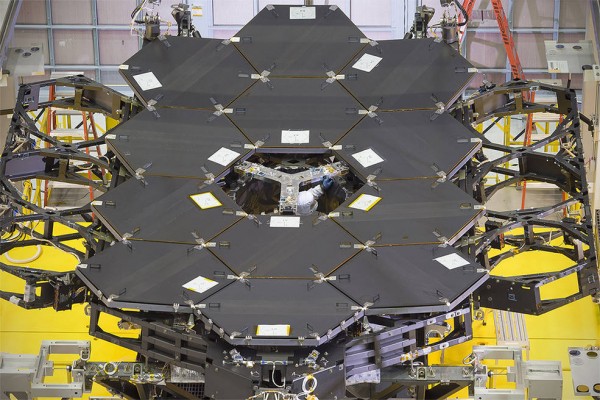By Ana Verayo, | January 26, 2016

One dozen (out of 18) flight mirror segments that make up the primary mirror on NASA's James Webb Space Telescope have been installed at NASA's Goddard Space Flight Center.
Right now, NASA and the European Space Agency are very close to completing the massive mirror of a US $8 billion space telescope this week, which will then be launched into space for a new mission, joining the famous Hubble Space Telescope.
Like Us on Facebook
After its successful completion, the James Webb Space Telescope will now become the precursor to Hubble and will be the world's most powerful space telescope. The JWST is designed to unravel the secrets of the universe, searching for clues about its evolution and history, beginning from the first light that ever shined after the Big Bang event, to the evolution of our very own solar system, including how life began on Earth.
According to NASA project scientist John Mather, this new telescope will now be capable of discovering new worlds, cosmic events and objects that are not yet conceivable by scientists. He adds how every time that bigger and more highly advanced technology are made, there is always an astonishing array of discoveries.
The telescope possesses a 6.5 meter long mirror which involves breakthrough technology for this ambitious project. There are about 18 segments put together using an ultra lightweight material known as beryllium and once this gets to a distance of 1 million miles from Earth, it will now begin observations where it will unravel like origami.
According to JWST project manager Bill Ochs, of NASA's Goddard Space Flight Center, everything is going quite well so far, where Ochs has been working for months during 10 hour shifts, attaching the hexagon shaped mirror segments to the telescope's "cobweb frame".
During the JWST launch, NASA will be cleared for liftoff on an Ariane 5 rocket lifting off from the French Guiana in South America, off the Atlantic coast in October 2018. The JWST will now join Hubble in monitoring cosmic activities, that Hubble has been doing so since 1990.
According to Ken Sembach, who is the head of the Hubble mission at the Space Telescope Science Institute, the observatory is in excellent condition right now, where the team is hoping to keep the space telescope operational to at least the year 2020.
Hubble not only captured the most iconic space images such as the Crab Nebula and the Eagle Nebula, also known as the Pillars of Creation. The iconic space telescope also yielded some groundbreaking scientific discoveries like how supermassive black holes lie in the center of the Milky Way galaxy and other spiral galaxies as well.
-
Use of Coronavirus Pandemic Drones Raises Privacy Concerns: Drones Spread Fear, Local Officials Say

-
Coronavirus Hampers The Delivery Of Lockheed Martin F-35 Stealth Fighters For 2020

-
Instagram Speeds Up Plans to Add Account Memorialization Feature Due to COVID-19 Deaths

-
NASA: Perseverance Plans to Bring 'Mars Rock' to Earth in 2031

-
600 Dead And 3,000 In The Hospital as Iranians Believed Drinking High-Concentrations of Alcohol Can Cure The Coronavirus

-
600 Dead And 3,000 In The Hospital as Iranians Believed Drinking High-Concentrations of Alcohol Can Cure The Coronavirus

-
COVID-19: Doctors, Nurses Use Virtual Reality to Learn New Skills in Treating Coronavirus Patients








